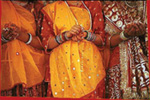Search
The Web
ashanet.org |
||||||
 |
| Main | About Us | Projects | Events | Get Involved | Donate | Links |
| Holi - from mythological past to present |
|
    |
Among
India's innumerable festivals, Holi ranks as the most colorful. It
heralds the arrival of spring with the promise of good harvests and
fertility and commemorates legends from Hindu mythology. Traditionally
celebrated on the first day after the full moon in early March, the
festival allows for the shedding of inhibitions and caste differences
in a rush of spring fever. It is characterized best by the water and
gulal, or colored powder, which are thrown upon one another in an
exuberant welcome of the season of love. The mythological roots of the festival vary across India. In South India, Kamadeva, the god of love, is thought to move through the woodlands hunting birds, beasts and men in the spring. Once, in his foolish pride, he aimed his arrow at the mighty Shiva who was in deep meditation. Shiva opened his third eye and burnt him to ash. Grief-stricken, Kamadeva's wife beseeched Shiva to take pity and restore her husband to life. Eventually, Shiva relented and granted the boon, though Kamadeva remained anang forever after, that is without physical form. The songs of Holi commemorate the lamentations of his unfortunate wife. In North India, Holi is inextricably linked to the legend of Krishna. The cruel king Kamsa sent the she-demon Putana to murder the child Krishna. In the guise of a beautiful woman, Putana went about the village of Nandgaon suckling every child to death. The infant Krishna, however, was able overcome the demoness. Symbolically, the death of Putana has come to represent the end of the suffocating gloom of winter. A third story centers around the arrogant king Hiranyakashyapu who ordered his people to worship him as a god. Defying the order, his son Prahlad continued to worship Vishnu. Thus, the king sent his sister, the demoness Holika, who enjoyed the boon of being immune to fire, to murder his son. She cajoled the young Prahlad to sit in her lap as she took a seat in a blazing fire. In another victory of good over evil, Prahlad remained unscathed as his aunt burned to death. In memory of Holika's destruction, bonfires are built throughout northern India on the eve of Holi. The festival is also associated with the immortal love of Radha and Krishna who are thought to have taken part in the first smearing of gulal in the forests of Vrindavan. The flirtatious and colorful play of modern Holi harkens back to Krishna's relentless chase after Radha and the gopis. |
| Asha for Education is a registered 501(c)(3) non-profit charitable organization. |